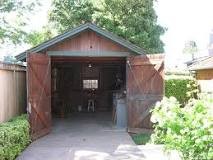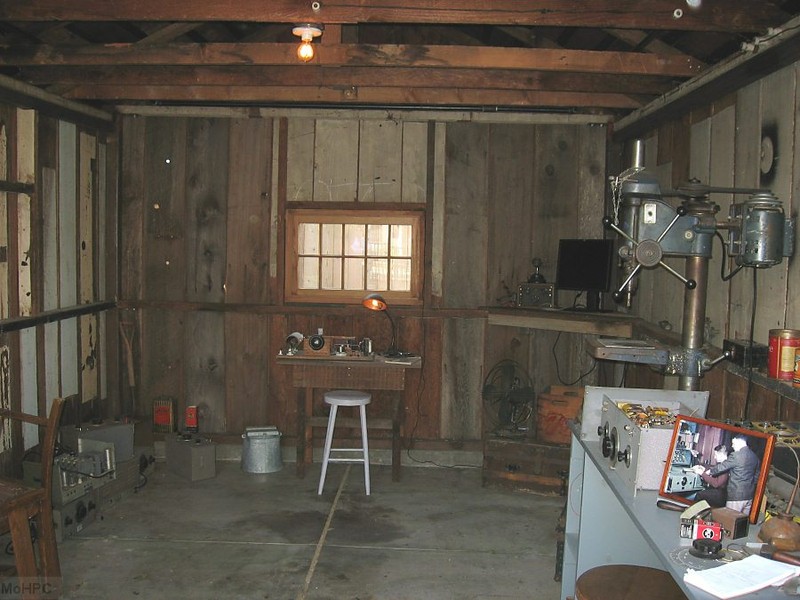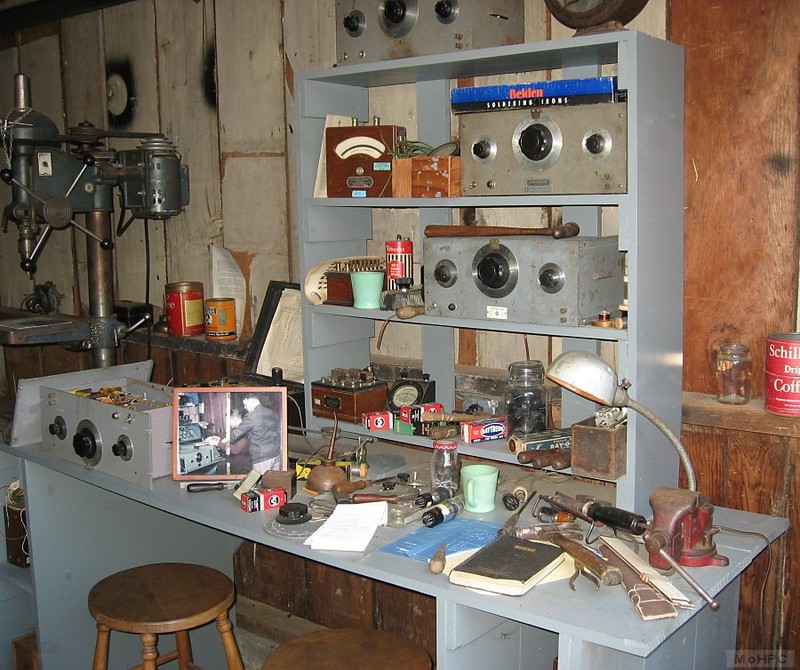HP Garage
Introduction
Text-to-speech Audio
The famed “HP Garage,” as well as the adjoining two-story house and shed, were the birthplace of the Hewlett-Packard Company (HP), and of Silicon Valley as a center of high-tech innovation. William “Bill” Hewlett and David “Dave” Packard, who had both been students of Prof. Frederick Terman (later known as "The Father of Silicon Valley"), worked at the property between 1938 and 1940. The two men started out with $538 in working capital, including a used drill press that Packard had brought west with him. In their first major success, they sold eight units of a variable frequency oscillator they had developed to the Walt Disney Company, which needed them for the rollout of its animated classic, Fantasia. Today, HP is a Fortune 500 company with billions of dollars in annual revenues. The property at 367 Addison was the company’s headquarters until 1940, by which time the company had outgrown the original site and moved elsewhere.
The property was registered as California Registered Landmark No. 976 in August 1987 and was placed on the National Register of Historic Places in 2007.
Images
HP Garage

The interior of the HP Garage

The bench in the interior of the garage

The plaque outside the garage, commemorating it as the "Birthplace of Silicon Valley"

Backstory and Context
Text-to-speech Audio
Dave Packard and Bill Hewlett had met when both young men were engineering students of Dr.
Frederick Terman at Stanford University. Dr. Terman encouraged his students to utilize their
skills locally, in California, rather than for the big companies on the east coast, which at that time (the 1930s) did most of the hiring of engineering graduates. Nevertheless, after graduation Dave Packard got a job on the east coast (in Schenectady, New York)
for General Electric. However, he kept in touch with Hewlett, and in 1937 discussed with him the possibility of their going into business together. Dr. Terman, in the following year, got Packard a job at Stanford, and
the latter took a leave of absence from G.E. and moved back west with his new wife, Lucile.
Meanwhile, Hewlett discovered the property at 367 Addison, and was attracted to it because it had a garage, which measured 12 by 18 feet and included a workbench, that he and Packard could use as a workshop. The house had been built in 1905 by Dr. John C. Spencer, and the garage had existed since at least 1924, when it was first listed in insurance records. (The Santa Clara Valley was mostly an agricultural area when Packard and Hewlett started working there.) The rent was a very affordable $45 a month. The Packards lived in the two-story house and Hewlett in a small shed on the property. Lucile Packard did the correspondence and bookkeeping for the company in the house, while the men worked in the garage. The team designed a number of products, including for a hospital and even a bowling alley.
With Dr. Terman’s encouragement, they developed a variable frequency oscillator, which measures sound frequencies, by Christmas 1938, calling it the Model 200A. At the same time, they produced another model, the 200B oscillator, and created a brochure to market it to 25 potential customers. An engineer at the Walt Disney Company became interested and, needing oscillators for the release of Disney's classic animated film, Fantasia, the company purchased eight units of Model 200B: the partners' first major sale. In January, 1939, Packard quit G.E. and the pair formalized their partnership, deciding on the name “Hewlett-Packard” on a coin toss that, one presumes, Hewlett won. In their first year of operation, with two employees, the company produced 200 oscillators, which they produced entirely themselves, except for the enclosing cabinets and engraving. By early 1940, the company had outgrown its cramped workshop and moved to other quarters.
It was in the postwar period that Dr. Terman, Hewlett’s and Packard’s former professor and mentor, laid the foundation for the valley region as a high technology center, with Stanford University as its core, creating the first high-tech industrial research park near the campus. In 1953, Hewlett and Packard moved their still relatively new company to the Stanford Research Park. The team then helped promote the park. Silicon Valley is now home to over 4500 high-tech organizations, largely thanks to HP’s pioneering work and reputation. In 1989, when the site at 367 Addison was officially dedicated as the "Birthplace of Silicon Valley,” both Packard and Hewlett were present for the dedication ceremony.
The entire property – house, garage and shed – was purchased in 2000 by HP for $1.7 million. With the cooperation of the City of Palo Alto, a complete rehabilitation of the property was begun in 2005 by HP, which restored its original appearance and architectural integrity. The single-story rectangular garage, located at the west corner of the property, is topped by a single gabled roof with a broad eave. The framing of the walls and roof are exposed, and the floor is a concrete slab. Deteriorating shingles were replaced with new shingles. A plaque in front of the garage identifies it as the "Birthplace of Silicon Valley.” Because it is located in a quiet residential neighborhood near Stanford University, the garage and house are not open to tours, but they can be viewed and photographed from the street.
The garage, as well as the house and shed on the property, are undistinguished architecturally. The property’s only significance is as the historical start of a major corporation and of the phenomenon of “Silicon Valley.” According to Paul Lusignan, a historian with the National Register of Historic Places in Washington, “The significance of the garage and the house is more associated with the entrepreneurial spirit in which it was developed.” As an article in Fortune magazine in 1974 states, “Whenever local high-technology leaders discuss the beginnings of Silicon Valley, the garage is noted as the place 'where it all began.’”
Meanwhile, Hewlett discovered the property at 367 Addison, and was attracted to it because it had a garage, which measured 12 by 18 feet and included a workbench, that he and Packard could use as a workshop. The house had been built in 1905 by Dr. John C. Spencer, and the garage had existed since at least 1924, when it was first listed in insurance records. (The Santa Clara Valley was mostly an agricultural area when Packard and Hewlett started working there.) The rent was a very affordable $45 a month. The Packards lived in the two-story house and Hewlett in a small shed on the property. Lucile Packard did the correspondence and bookkeeping for the company in the house, while the men worked in the garage. The team designed a number of products, including for a hospital and even a bowling alley.
With Dr. Terman’s encouragement, they developed a variable frequency oscillator, which measures sound frequencies, by Christmas 1938, calling it the Model 200A. At the same time, they produced another model, the 200B oscillator, and created a brochure to market it to 25 potential customers. An engineer at the Walt Disney Company became interested and, needing oscillators for the release of Disney's classic animated film, Fantasia, the company purchased eight units of Model 200B: the partners' first major sale. In January, 1939, Packard quit G.E. and the pair formalized their partnership, deciding on the name “Hewlett-Packard” on a coin toss that, one presumes, Hewlett won. In their first year of operation, with two employees, the company produced 200 oscillators, which they produced entirely themselves, except for the enclosing cabinets and engraving. By early 1940, the company had outgrown its cramped workshop and moved to other quarters.
It was in the postwar period that Dr. Terman, Hewlett’s and Packard’s former professor and mentor, laid the foundation for the valley region as a high technology center, with Stanford University as its core, creating the first high-tech industrial research park near the campus. In 1953, Hewlett and Packard moved their still relatively new company to the Stanford Research Park. The team then helped promote the park. Silicon Valley is now home to over 4500 high-tech organizations, largely thanks to HP’s pioneering work and reputation. In 1989, when the site at 367 Addison was officially dedicated as the "Birthplace of Silicon Valley,” both Packard and Hewlett were present for the dedication ceremony.
The entire property – house, garage and shed – was purchased in 2000 by HP for $1.7 million. With the cooperation of the City of Palo Alto, a complete rehabilitation of the property was begun in 2005 by HP, which restored its original appearance and architectural integrity. The single-story rectangular garage, located at the west corner of the property, is topped by a single gabled roof with a broad eave. The framing of the walls and roof are exposed, and the floor is a concrete slab. Deteriorating shingles were replaced with new shingles. A plaque in front of the garage identifies it as the "Birthplace of Silicon Valley.” Because it is located in a quiet residential neighborhood near Stanford University, the garage and house are not open to tours, but they can be viewed and photographed from the street.
The garage, as well as the house and shed on the property, are undistinguished architecturally. The property’s only significance is as the historical start of a major corporation and of the phenomenon of “Silicon Valley.” According to Paul Lusignan, a historian with the National Register of Historic Places in Washington, “The significance of the garage and the house is more associated with the entrepreneurial spirit in which it was developed.” As an article in Fortune magazine in 1974 states, “Whenever local high-technology leaders discuss the beginnings of Silicon Valley, the garage is noted as the place 'where it all began.’”
Sources
"Founding HP." HP (Hewlett-Packard website). Access Date: 10/4/16. http://www8.hp.com/us/en/hp-information/about-hp/history/founders.html.
"Birthplace of Silicon Valley: Historic Landmark." California Office of Historic Preservation (OHP). Access Date: 10/4/16. http://ohp.parks.ca.gov/ListedResources/Detail/976.
Dreyfuss, Alan R., "Hewlett-Packard House and Garage: National Register of Historic Places Registration Form." U.S. Department of the Interior, National Park Service. 3/9/07. Access Date: 10/4/16. http://focus.nps.gov/GetAsset?assetID=7b6f8587-d458-4bf6-8d0e-1d260e60dee5.
"HP Garage (PDF document)." HP Official Site. Access Date: 10/4/16. http://www8.hp.com/us/en/pdf/brief_tcm_245_948414.pdf.
Poletti, Therese. "HP garage named U.S. landmark (archived article)." Mercury News. 5/18/07. Access Date: 10/4/16. http://web.archive.org/web/20070521095141/http://www.siliconvalley.com/ci_5925786?nclick_check=1.
Associated Press. "Hewlett-Packard garage given U.S. historical designation." Seattle Times. 5/19/07. Access Date: 10/4/16. http://www.seattletimes.com/nation-world/hewlett-packard-garage-given-us-historical-designation.
